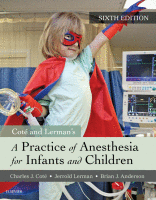Physical Address
304 North Cardinal St.
Dorchester Center, MA 02124

EMERGENCE FROM ANESTHESIA IN CHILDREN differs substantially compared with adults. The process is multifaceted, dependent on the nature of the surgery, patient characteristics, and the type of anesthesia administered. In young children, emergence from inhalational agents can be quite rapid…

the approach to providing anesthesia outside the operating room (OR) for children (also known as “non–operating room anesthesia” [NORA] or “Off-site Anesthesia”) varies greatly among health care organizations and even from one anesthesia provider to another. Because of its very…

THE PRACTICING PEDIATRIC ANESTHESIOLOGIST is involved in chronic pain in one of three main venues: a child who is scheduled for a procedure, in consultation, or during acute pain management rounds. In this chapter, we focus on the essential approaches…

the practice of pain management in children continues to advance. Since the early 1980s, clinicians have recognized that neonates and infants experience pain and process those learning experiences. Research has demonstrated long-term adverse consequences of unrelieved pain, including harmful neuroendocrine…

peripheral nerve blocks are frequently performed in children to provide anesthesia or analgesia during the perioperative period. Success depends on the ability to accurately place the needle—and thereby the local anesthetic—close to the target nerve without causing injury to the…

THE USE OF REGIONAL anesthesia techniques in children has increased dramatically in the past two decades. Regional anesthesia is most commonly used in conjunction with general anesthesia in children, although in certain circumstances regional anesthesia may be the sole technique.…

MALIGNANT HYPERTHERMIA (MH) is a pharmacogenetic disease of skeletal muscle that may precipitate a potentially fatal sequence of metabolic responses in the presence of triggering anesthetics. The primary triggers for MH—inhalational anesthetics and succinylcholine—induce an uncontrollable release of intramyoplasmic calcium…

THE PEDIATRIC ANESTHESIOLOGIST must be prepared to resuscitate a child who suffers a cardiac arrest in the course of a routine elective anesthetic, during a high-risk surgery, or outside the operating room (OR) during the delivery of an anesthetic or…

ANESTHESIOLOGISTS COMMONLY PROVIDE CARE TO CHILDREN who have suffered traumatic injuries of varying complexity. They range from the healthy, older child with an isolated elbow fracture to the infant with a life-threatening epidural hematoma. The anesthesiologist should view the management…

the advent of fetal intervention introduced the concept of surgically correcting or ameliorating known congenital defects in utero. With improvements in prenatal imaging and surgical techniques, fetal interventions have grown to include diagnoses associated with intrauterine demise and significant postnatal…